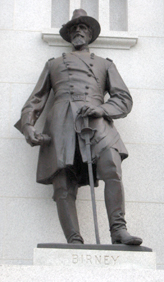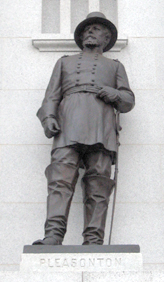The State of Pennsylvania monument is south of Gettysburg on Hancock Avenue at Pleasonton Avenue. (Hancock Avenue Part 2 tour map or Pleasonton Avenue tour map) The monument was dedicated on September 27th, 1910, and the statues on each side of the arches were added after April of 1913.

State of Pennsylvania Monument at Gettysburg
About the State of Pennsylvania Monument
The State of Pennsylvania Monument is the largest monument on the Gettysburg battlefield. The tip of the sword of the statue of Winged Victory is 110 feet high. A spiral staircase takes visitors to the roof of the monument, which offers a panoramic view of the battlefield.
The monument is made from North Carolina granite set over an iron and concrete frame. Rising over all Sculptor Samuel Murray created a 7,500 pound statue of Winged Victory from melted down Civil War cannons which stands on top of the dome. He also created the reliefs over each of the arches.
>> See the view from the top of the State of Pennsylvania monument <<<
Inscriptions from the tablets around the entrances
From the inscriptions flanking the front entrance:
The Commonwealth of Pennsylvania
In honor of her sons who on this field fought for the Preservation of the Union July 1.2. & 3. 1863
Pennsylvania at Gettysburg
69 Regiments Infantry
9 Regiments Cavalry
7 Batteries Artillery
Total Present 34530
Killed and mortally wounded 1182
Wounded 3177 Missing 860
From the tablet inside the entrance:
Memorial to the soldiers of Pennsylvania who fought
at Gettysburg July, 1863, erected under authority
of acts of the General Assembly of Pennsylvania
approved June 13, 1907, and February 11, 1909, by
Edwin S. Stuart
Governor of the Commonwealth
The commissioners charged with the selection of the design for the memorial and the construction of it, and who undertook the collection of the names and figures and other data theron, which, necessarily, are approximate, were
St. Clair A. Mulholland – Henry S. Huidekoper – John P. Taylor, Charles F. McKenna – Edward L. Whittelsey, George P. Morgan – Charles E. Quail – Edward A. Irvin, Henry H. Cumings – Jacob C. Stineman
From the tablet on the inside right entryway:
To the Loyal Women who through four years of war, endured suffering and bereavement.This tablet is dedicated
in grateful recognition of their patriotism by the men of Pennsylvania
who served in the Army and Navy of the United
States during the War of the Rebellion.
From the inscription on the inside right entryway:
Pennsylvania Soldiers of the Army of the Potomac
who participated in the Battle of Gettysburg
2133 Officers of whom 73 were killed or mortally wounded
32,144 enlisted men of whom 1139 were killed or mortally wounded
Total engaged or on duty 34,247 – total killed or mortally wounded 1212
There were required in the construction of the Pennsylvania Memorial:
1252 tons of cut granite
740 tons of sand
366 tons of cement
1240 tons of broken stone
50 tons of steel
22 tons of bronze
Total 3840 tons
From the tablet at the stairway:
Memorial erected in 1910
Dedicated September 27 1910
W. Liance Cotrell Architect
Samuel A. Murray Sculptor
Harrison Granite Co. Contractors
Regimental and Battery rosters
The base and the interior of the monument are lined with bronze tablets of the Pennsylvania regiments and batteries who fought in the Battle of Gettysburg. Each tablet lists the roster by company of the officers and men of that unit. The monument has the names of over 34,000 Pennsylvanians who participated in the battle.

Each of the stone arches leading into the interior of the monument is flanked by a pair of larger than life bronze statues and topped with a relief representing infantry, cavalry, artillery, and signals. The group of bronze statues is made up of President Lincoln, Pennsylvania’s Governor Curtin, and the six highest ranking Pennsylvania generals in the Battle of Gettysburg.
West side of the monument

Infantry frieze over the west arch of the State of Pennsylvania Monument
Pennsylvania Governor Andrew Curtin and President Lincoln flank the entryway on the west side of the monument:
 Governor Andrew Curtain |
 President Abraham Lincoln |
North side of the monument

Artillery frieze over the north arch of the State of Pennsylvania Monument
Corps commander Major General John F. Reynolds and army commander Major General George Meade are on the north side of the monument:
 Major General John F. Reynolds |
 Major General George G. Meade |
South side of the monument

Cavalry frieze over the south arch of the State of Pennsylvania Monument
Division commander Major General David Birney and Cavalry Corps commander Major General Alfred Pleasonton are on the south side:
 Major General David Birney |
 Major General Alfred Pleasonton |
East side of the monument

Signal Corps frieze over the east arch of the State of Pennsylvania Monument
Corps commander Major General Winfield S. Hancock and division commander Major General David M. Gregg are on the east side:
 Major General Winfield S. Hancock |
 Major General David M. Gregg |

Location of the State of Pennsylvania monument at Gettysburg
The State of Pennsylvania Monument is south of Gettysburg on Hancock Avenue at Pleasonton Avenue. Hancock Avenue is one way northbound. (39°48’27.6″N 77°14’06.6″W)
